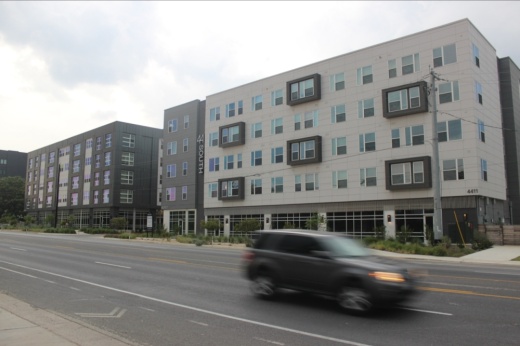The background
City Council voted to expand the existing vertical mixed-use development program in spring 2022. That update, labeled VMU2, was intended to bring more housing featuring ground-floor retail and office space to Austin's most heavily traveled corridors.
Through both iterations of the mixed-use program, new buildings could be granted several additional stories in height as long as developers also provided some affordable housing.
However, VMU2 was one of three council-backed land development code updates that were overturned in December following a resident lawsuit that successfully challenged how the city had implemented those changes.
More than 17,600 residential units were built or are now in planning under the original VMU, including 2,535 income-restricted affordable spaces, as of February. Hundreds more were proposed under VMU2 since its creation.
What's happening
After VMU2 was voided, city officials sought to lay out a replacement that could still promote taller buildings with affordable housing.
That new option is called DB90, a density bonus allowing for a maximum 90 feet of height, and was approved by City Council on Feb. 29.
By utilizing DB90:
- Up to 30 feet of extra height can be tacked onto a site's base zoning allowance.
- 10% to 12% of a project's residential units must be income-restricted.
- A majority of a project's ground floor must be be "pedestrian-oriented" commercial space.
While VMU2 was limited to major corridors, DB90's reach extends citywide. The program can be accessed on many of Austin's commercial and office properties regardless of what street they're on.
Another key difference between the old and new programs is that property owners seeking to take advantage of DB90 must first rezone their land, a process that includes public review.
VMU2 was invalidated given that it was broadly applied to all affected properties in Austin without individual public notice. District Court Judge Jessica Mangrum ruled the city's approach had skirted state law requiring that residents be notified and have the chance to protest such zoning changes.
With council's approval of DB90, rezonings for all projects that had sought to build under VMU2 were also launched to capture them under the new rules.
What else?
DB90 was passed without any protections that'd prevent the displacement of current tenants living in the many buildings that could now be targeted for redevelopment.
City staff said they'd initially wanted to include such safeguards. If someone wanted to tear down existing housing and build under DB90, planners had proposed they should:
- Prove an existing multifamily development required “extensive repairs” worth at least half the structure's value before demolition.
- Replace all existing affordable housing in the redevelopment with new units including comparable bedroom counts.
- Provide notification and relocation benefits to current tenants.
- Offer current tenants the right to return to the site in a comparable residence at a comparable cost.
But for now, none of those guidelines will go into place—although they may still return in the future after more consideration—meaning any eligible properties could use DB90 regardless of their current state.
Bates said factors, including some stakeholders' concern about meeting the requirements and the city's public communications on the proposal, led staff to decide to cut out the protections.
Mayor Pro Tem Leslie Pool said she supported leaving out those added conditions in order to support DB90's launch.
“Certainly we’ve lost one of the biggest incentives to this program, which was the ease of process which adds up to savings on time and cost of a zoning application," Pool said Feb. 27. "If we add a lot of other requirements now, we run the risk of this program not being used at all. And obviously if we are taking the time and staff input and expertise to craft it, we want it to be a useful tool for members of our community.”
Put in perspective
Council member Chito Vela, a supporter of many recent changes to the city's development rules, said recent drops in Austin rents amid high residential construction activity show that updates like DB90 are needed to address affordability.
"When you look around the country, when you look at Los Angeles, San Francisco, Boston who are not building housing, who are making it as difficult as possible to build housing, you’re seeing skyrocketing rents. You’re seeing people continuing to be horribly displaced out of those cities," Vela said Feb. 29. "The strategy is clear. The results are clear. We’ve got to continue to build more housing. I’m very proud of this council for doing that, and I fully intend to continue doing that.”
DB90 was opposed by some community members, including representatives with the community coalition Go Austin/Vamos Austin, over concerns about its potential to worsen the effects of gentrification in lower-income communities.
Similar worries have been shared by GA/VA and many others as city officials forged ahead on various land-use changes in the past few years, including their passage of Phase 1 of the "HOME" initiative last year.
GA/VA Policy Director Monica Guzmán told council members DB90 will bring disproportionate impacts to mixed- and lower-income housing communities across Austin.
“The use of a density bonus on these areas without adequate affordability and anti-displacement components represents a continued exploitation and harm to the people in these neighborhoods who are negatively impacted by gentrification," she said.
Council member Alison Alter—who'd supported VMU2 and some other targeted moves to support more housing options—said she couldn't get behind DB90 in its current form given community concerns about added height and density and the loss of "safeguards" previously included in VMU2.
“I’m very glad that we are capturing affordable housing requirements as part of this combining district, but I think we could have calibrated this more precisely to be thoughtful about how to make this combining area work for different areas and contexts. This proposal is not going to have equal consequences across the city," she said.
DB90 was approved with Alter against and council member Mackenzie Kelly abstaining.





